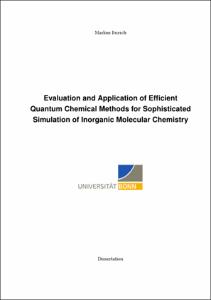Bursch, Markus: Evaluation and Application of Efficient Quantum Chemical Methods for Sophisticated Simulation of Inorganic Molecular Chemistry. - Bonn, 2021. - Dissertation, Rheinische Friedrich-Wilhelms-Universität Bonn.
Online-Ausgabe in bonndoc: https://nbn-resolving.org/urn:nbn:de:hbz:5-64805
Online-Ausgabe in bonndoc: https://nbn-resolving.org/urn:nbn:de:hbz:5-64805
@phdthesis{handle:20.500.11811/9485,
urn: https://nbn-resolving.org/urn:nbn:de:hbz:5-64805,
author = {{Markus Bursch}},
title = {Evaluation and Application of Efficient Quantum Chemical Methods for Sophisticated Simulation of Inorganic Molecular Chemistry},
school = {Rheinische Friedrich-Wilhelms-Universität Bonn},
year = 2021,
month = dec,
note = {This thesis is devoted to the evaluation and application of efficient quantum chemical methods for the simulation of inorganic molecular chemistry. These methods include dispersion corrected density functional theory (DFT-D) and semi-empirical electronic structure methods, which represent a beneficial compromise of computational speed and accuracy and can be applied to large systems with hundreds to thousands of atoms. Nevertheless, with increasing size and complexity of the investigated system, the number of reasonably applicable methods decreases rapidly. Especially semi-empirical quantum mechanical (SQM) methods are often not universally applicable due to incomplete parametrizations or conceptual shortcomings. Despite the desirable properties of efficient SQM methods, the so-called parametric methods (PMx) were for a long time the only more widely applicable representatives. This changed with the more recently developed extended tight binding methods of the GFNn-xTB family which are parametrized for a major part of the periodic table up to radon (Z = 86). Although the conception of the GFNn-xTB methods is generally promising, the performance for more exotic chemical systems or in combination with other methods to enable new efficient workflows for the computation of complex chemical properties, has yet to be examined. Therefore, this thesis deals with the application of the GFNn-xTB methods for the calculation of structures of large transition metal and lanthanoid complexes. Further, their capability to compute thermochemical properties, such as conformational energies of transition metal complexes is assessed and combinations of the GFNn-xTB and DFT-3c methods are applied to chemical problems in the field of frustrated Lewis pair (FLP) chemistry. Moreover, efficient quantum chemical methods are applied to inorganic main group chemistry, focusing on the group 14 elements, including studies on London dispersion effects and the assessment of popular DFT methods for the prediction of 29Si NMR chemical shifts. Overall, this thesis establishes the foundation for future studies in the fields of inorganic main group, transition metal, and lanthanoid chemistry based on efficient combination of London dispersion corrected SQM and DFT methods. The GFNn-xTB and DFT-3c methods are shown to be reliable and invaluable tools for computational chemists, that reduce the computational demand for various quantum chemical applications. Specifically, the GFNn-xTB methods open up the fully quantum mechanical description of inorganic molecules and reaction mechanisms at previously inaccessible scales. Further, the benchmark sets created throughout this thesis will be of inestimable value for future method development. The detailed insights into the decisive role of London dispersion interactions and the bonding situation in complex inorganic molecules will also enhance the perception on London dispersion as an indispensable aspect in the design and planning of new chemical applications.},
url = {https://hdl.handle.net/20.500.11811/9485}
}
urn: https://nbn-resolving.org/urn:nbn:de:hbz:5-64805,
author = {{Markus Bursch}},
title = {Evaluation and Application of Efficient Quantum Chemical Methods for Sophisticated Simulation of Inorganic Molecular Chemistry},
school = {Rheinische Friedrich-Wilhelms-Universität Bonn},
year = 2021,
month = dec,
note = {This thesis is devoted to the evaluation and application of efficient quantum chemical methods for the simulation of inorganic molecular chemistry. These methods include dispersion corrected density functional theory (DFT-D) and semi-empirical electronic structure methods, which represent a beneficial compromise of computational speed and accuracy and can be applied to large systems with hundreds to thousands of atoms. Nevertheless, with increasing size and complexity of the investigated system, the number of reasonably applicable methods decreases rapidly. Especially semi-empirical quantum mechanical (SQM) methods are often not universally applicable due to incomplete parametrizations or conceptual shortcomings. Despite the desirable properties of efficient SQM methods, the so-called parametric methods (PMx) were for a long time the only more widely applicable representatives. This changed with the more recently developed extended tight binding methods of the GFNn-xTB family which are parametrized for a major part of the periodic table up to radon (Z = 86). Although the conception of the GFNn-xTB methods is generally promising, the performance for more exotic chemical systems or in combination with other methods to enable new efficient workflows for the computation of complex chemical properties, has yet to be examined. Therefore, this thesis deals with the application of the GFNn-xTB methods for the calculation of structures of large transition metal and lanthanoid complexes. Further, their capability to compute thermochemical properties, such as conformational energies of transition metal complexes is assessed and combinations of the GFNn-xTB and DFT-3c methods are applied to chemical problems in the field of frustrated Lewis pair (FLP) chemistry. Moreover, efficient quantum chemical methods are applied to inorganic main group chemistry, focusing on the group 14 elements, including studies on London dispersion effects and the assessment of popular DFT methods for the prediction of 29Si NMR chemical shifts. Overall, this thesis establishes the foundation for future studies in the fields of inorganic main group, transition metal, and lanthanoid chemistry based on efficient combination of London dispersion corrected SQM and DFT methods. The GFNn-xTB and DFT-3c methods are shown to be reliable and invaluable tools for computational chemists, that reduce the computational demand for various quantum chemical applications. Specifically, the GFNn-xTB methods open up the fully quantum mechanical description of inorganic molecules and reaction mechanisms at previously inaccessible scales. Further, the benchmark sets created throughout this thesis will be of inestimable value for future method development. The detailed insights into the decisive role of London dispersion interactions and the bonding situation in complex inorganic molecules will also enhance the perception on London dispersion as an indispensable aspect in the design and planning of new chemical applications.},
url = {https://hdl.handle.net/20.500.11811/9485}
}






